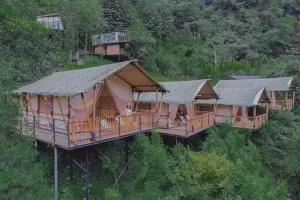Luxury glamping tents are designed to integrate seamlessly with their natural surroundings, enhancing the outdoor experience while minimizing environmental impact. Here are key ways in which these tents achieve this integration:
1. Site Selection and Planning
- Natural Landscape Consideration: The placement of tiendas de campaña de lujo is carefully planned to highlight the natural beauty of the site, such as scenic views or unique topography. This ensures that the tents enhance rather than compete with the environment.
- Environmental Impact Minimization: Sites are chosen to avoid disrupting local ecosystems, with considerations for soil erosion and habitat preservation. Engaging with local communities can provide insights into suitable locations that align with environmental guidelines.

2. Sustainable Materials
- Eco-Friendly Construction: Many luxury glamping tents are made from sustainable materials, including recycled fabrics and low-impact construction methods. This commitment to eco-consciousness helps reduce the overall ecological footprint of the accommodations.
- Natural Aesthetics: The design often incorporates natural colors and textures that blend harmoniously with the surrounding landscape, creating a visually appealing environment that feels organic and inviting.

3. Energy Efficiency and Renewable Resources
- Renewable Energy Solutions: Luxury glamping sites frequently utilize solar panels, wind turbines, and other renewable energy sources to power amenities within the tents. This reduces reliance on traditional energy grids and minimizes carbon footprints.
- Natural Ventilation: Many tents are designed with features that promote natural airflow, reducing the need for mechanical cooling and heating systems while enhancing guest comfort.

4. Outdoor Living Spaces
- Seamless Transition to Nature: Luxury glamping designs often include outdoor living areas such as decks, patios, or fire pits that encourage guests to engage with their surroundings. These spaces facilitate relaxation and social interaction while maintaining a connection to nature.
- Panoramic Views: Large windows or transparent panels allow for unobstructed views of the landscape, creating an immersive experience where guests can enjoy the beauty of nature from within their tent.

5. Community Engagement and Education
- Local Partnerships: Many glamping operations prioritize collaboration with local communities to ensure that their presence benefits the region socially and economically. This engagement can also enhance guests’ understanding of local culture and ecology.
- Educational Initiatives: Some glamping sites provide educational materials about local ecosystems and sustainable practices, encouraging guests to adopt environmentally friendly behaviors during their stay.

Conclusión
Luxury glamping tents exemplify a harmonious blend of comfort and environmental responsibility. Through thoughtful site selection, sustainable materials, energy efficiency, outdoor integration, and community engagement, these accommodations offer guests a unique opportunity to enjoy nature without compromising on luxury or ecological integrity.




